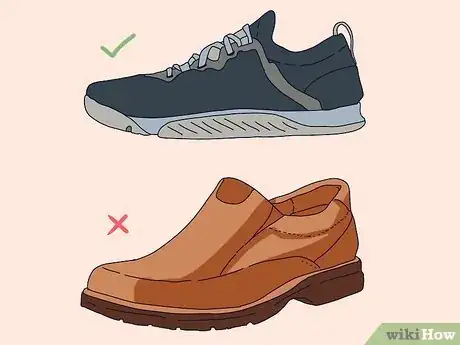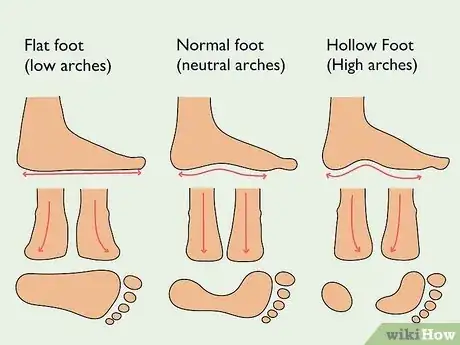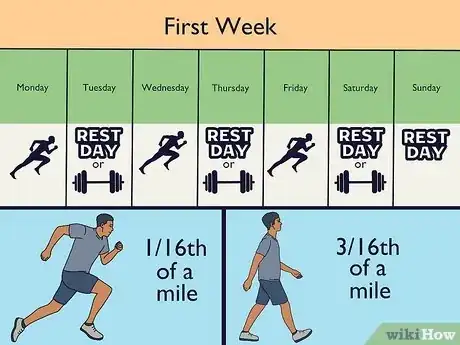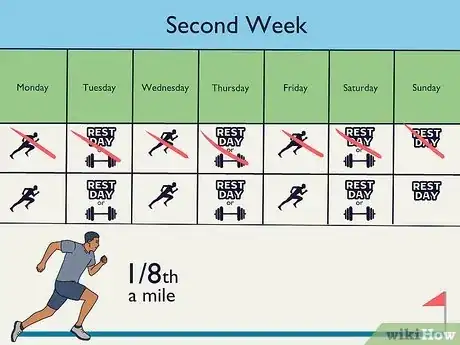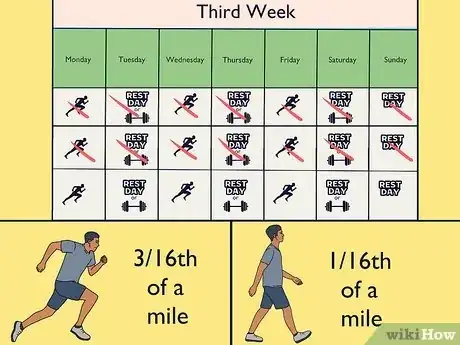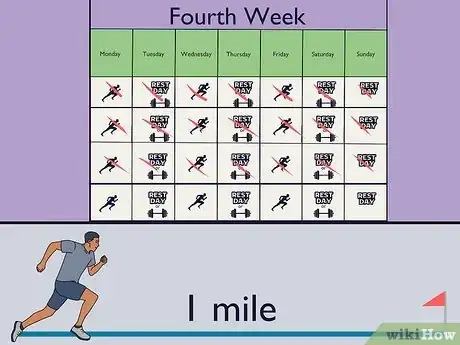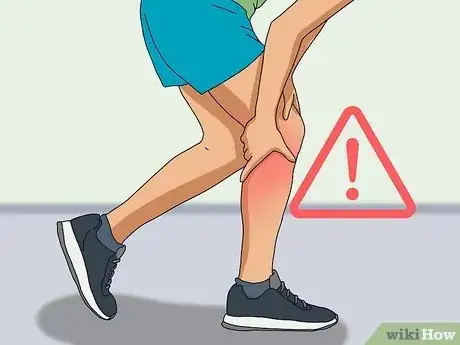This article was co-authored by Kai Ng. Kai Ng is a USATF and RRCA Certified Running Coach at Run Coach Kai. Kai has competed in over 55 races and over 15 marathons, and has trained with 16x USA and World record holder Patti Catalano Dillonso. He specializes in coaching runners of all levels and showing people that everyone can be a runner. Kai is committed to helping his clients reach their goals by showing them how to run with proper form and holding them accountable to train consistently.
This article has been viewed 79,504 times.
Running is a simple and enjoyable exercise that you can use to get in shape, deal with stress, and lose weight. If you are new to running, setting a goal of running one mile can be a great way to get started. Running a mile without stopping is an achievable goal and your success can help encourage you to make running a regular part of your life.
Steps
Getting the Right Shoes
-
1Look for running shoes. There are many different styles of athletic shoes that are available for purchase. However, in order to make your runs safe and more effective you will need to purchase running shoes. Running shoes are designed to properly absorb impact, be lightweight, and are fit specifically to your foot.
- Cross-training shoes or other athletic shoes won't provided the same support as running shoes.
- Avoid running in non-athletic shoes.
-
2Have your gait analyzed. Most specialty stores will offer to analyze your gait. Staff will have you run on a treadmill and study how you run, where your land on your feet, and decide which running shoe would be right for you. This custom fit can help prevent injury and improve your run. Try visiting a specialty running shoe store when looking for new shoes.Advertisement
-
3Know what type of foot you have. Before you start looking for the perfect pair of running shoes, it can be a good idea to learn what type of foot you have. The main feature of the foot that you will be looking at is the arch. Depending on the size and shape of the arch, you will need to buy a pair of shoes that have more or less support in this area.
- Low arches are more flexible and may roll too far to the inside when running.
- Neutral arches are ideal and balance the weight of impact well.
- High arches are often inflexible and may cause you to land heavily on the side of your foot.
Building up to a Mile
-
1Start your first week. This training plan will allow you to slowly increase the amount you can comfortably run, over the course of four weeks. Each week will add more distance and time to your jog, allowing you to meet your goals. Try to follow this schedule for your first week:
- On days 1, 3 and 5, do four sets of running 1/16th of a mile and walking 3/16th of a mile.
- On days 2, 4, and 6, rest or cross train.
- On the seventh day, take a break.
EXPERT TIPTyler Courville is a brand ambassador for Salomon Running. He has run in 10 ultra and mountain races across the United States and Nepal, and won the 2018 Crystal Mountain Marathon.Professional Runner
 Tyler Courville
Tyler Courville
Professional RunnerCreate rituals around your running schedule, and allow time for rest. Tyler Courville, ultra and mountain runner, adds: “It’s crucial to recognize when you’ve had a really good day. Give yourself credit for having done it, and be fine with taking as much rest as you need.”
-
2Move into your second week. During the second week of training, you will increase the amount you jog and decrease the amount you walk. This will allow you to progress towards your goal of running one mile, without over stressing or over training your body. Follow this schedule for your second week of training:
- On days 1, 3 and 5, do four sets of running 1/8th of a mile and walking 1/8th of a mile.
- On days 2, 4, and 6, rest or cross train.
- On the seventh day, take a break.
-
3Keep pushing into your third week. During the third week of training, you will be approaching your goal of running one mile without stopping. This week will continue increasing the amount you are able to run and will continue to build cardiovascular endurance. Use this training schedule for you third week of running:
- On days 1,3 and 5, do four sets of running 3/16th of a mile and walking 1/16th of a mile.
- On days 2,4, and 6, rest or cross train.
- On the seventh day, take a break.
-
4Run a mile on your fourth week. Week four is the final week of your training program. You will be able to run a full mile by this point and will be doing so over the course of the week. Enjoy your accomplishment and keep your running routine strong by using this schedule:
- On days 1,3 and 5, run 1 mile.
- On days 2,4, and 6, rest or cross train.
- On the seventh day, take a break.
Improving Your Run
-
1Eat right. A big part of getting the most out of your runs is eating correctly. The foods you eat will have an effect on how far you are able to run, your energy levels, and the recovery process. Whenever you have a run coming up, try to keep some of these diet tips in mind to help you feel your best and run your hardest:[1]
- Foods with carbohydrates and protein are good choices.
- Try eating things like bread, pasta, and rice to get carbohydrates in your diet.
- Include things like meat, fish, and eggs to get enough protein.
-
2Warm up. Before doing any physical activity, it's a good idea to warm up.[2] Warming up before running can help prevent injury and improve the quality of your run. Keep some of these general tips in mind when warming up before a run.
- Walk for at least 5 to 10 minutes before a run.
- Doing some light stretching before a run can help you warm up.
- It's a good idea to cool down as well. Try walking for around 5 to 10 minutes after a run.
-
3Take breaks. Training too often or too much can increase the chances of injury. Although you may enjoy running, taking a break between runs can help keep you safe. Make sure that you are breaking up your running schedule to help keep you running strong.
- It's recommend that you run every other day.
- You might try cross-training on days off. For example, on days you don't run you may lift weights.
-
4Keep a routine. Running requires maintenance. If you take too much time off from running, you will find running more difficult when you come back to it. It's a good idea to make a regular schedule for your runs and stick to it, allowing you to avoid losing your ability to run a mile without stopping.[3]
- Include rest days in your schedule to allow your body time to recover.
- It can be fun to continue increasing the distance you run to help keep your routine interesting.
-
5Stay safe and prevent injury. Although running can improve your health and fitness, it may also cause injury. Injuries from running most commonly occur when a person pushes themselves too far, trains while injured, or over-trains. If you ever feel any pain during your runs or after, consider taking a break or cutting down on the distance you are running.[4]
- Make sure to increase distance gradually. Adding too much distance to your runs, without training for it, can cause injury.[5]
- Make sure your shoes are a good fit and are suitable for running.[6]
- Don't train while injured. Ask your doctor for other exercises you can do while the affected area heals.
Expert Q&A
-
QuestionWhy are many runners unsuccessful in improving endurance?
 Kai NgKai Ng is a USATF and RRCA Certified Running Coach at Run Coach Kai. Kai has competed in over 55 races and over 15 marathons, and has trained with 16x USA and World record holder Patti Catalano Dillonso. He specializes in coaching runners of all levels and showing people that everyone can be a runner. Kai is committed to helping his clients reach their goals by showing them how to run with proper form and holding them accountable to train consistently.
Kai NgKai Ng is a USATF and RRCA Certified Running Coach at Run Coach Kai. Kai has competed in over 55 races and over 15 marathons, and has trained with 16x USA and World record holder Patti Catalano Dillonso. He specializes in coaching runners of all levels and showing people that everyone can be a runner. Kai is committed to helping his clients reach their goals by showing them how to run with proper form and holding them accountable to train consistently.
Certified Running Coach When you work at 170 heartbeats per minute, you work at an anaerobic state. If you want to run at an aerobic state, you should work at 150 heartbeats per minute. Many runners cannot improve endurance because they run very fast and work their anaerobic systems instead of their aerobic systems.
When you work at 170 heartbeats per minute, you work at an anaerobic state. If you want to run at an aerobic state, you should work at 150 heartbeats per minute. Many runners cannot improve endurance because they run very fast and work their anaerobic systems instead of their aerobic systems. -
QuestionAre there any special tricks to make running easier when I haven't trained?
 Community AnswerMake sure to take deeply through your diaphragm, imagine yourself reaching the finish line, set a steady pace, and don't give up.
Community AnswerMake sure to take deeply through your diaphragm, imagine yourself reaching the finish line, set a steady pace, and don't give up. -
QuestionIs it possible for me to lift weights on the resting days? ( This is optional
 Community AnswerYes. Running and lifting weights can benefit each other when done correctly, and because your goal is to run one mile, they should not interfere with each other.
Community AnswerYes. Running and lifting weights can benefit each other when done correctly, and because your goal is to run one mile, they should not interfere with each other.
References
- ↑ http://www.nhs.uk/Livewell/Goodfood/Pages/Sport.aspx
- ↑ Kai Ng. Certified Running Coach. Expert Interview. 12 February 2021.
- ↑ http://www.sparkpeople.com/resource/fitness_articles.asp?id=1004
- ↑ http://www.mayoclinic.org/healthy-lifestyle/fitness/in-depth/overuse-injury/art-20045875?pg=2
- ↑ Kai Ng. Certified Running Coach. Expert Interview. 12 February 2021.
- ↑ Kai Ng. Certified Running Coach. Expert Interview. 12 February 2021.
